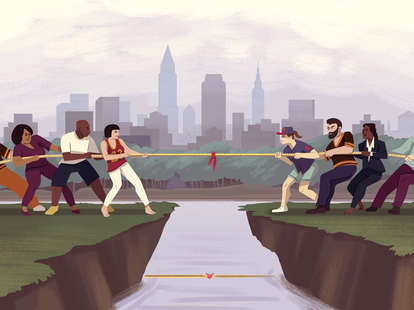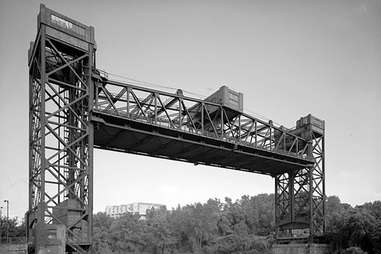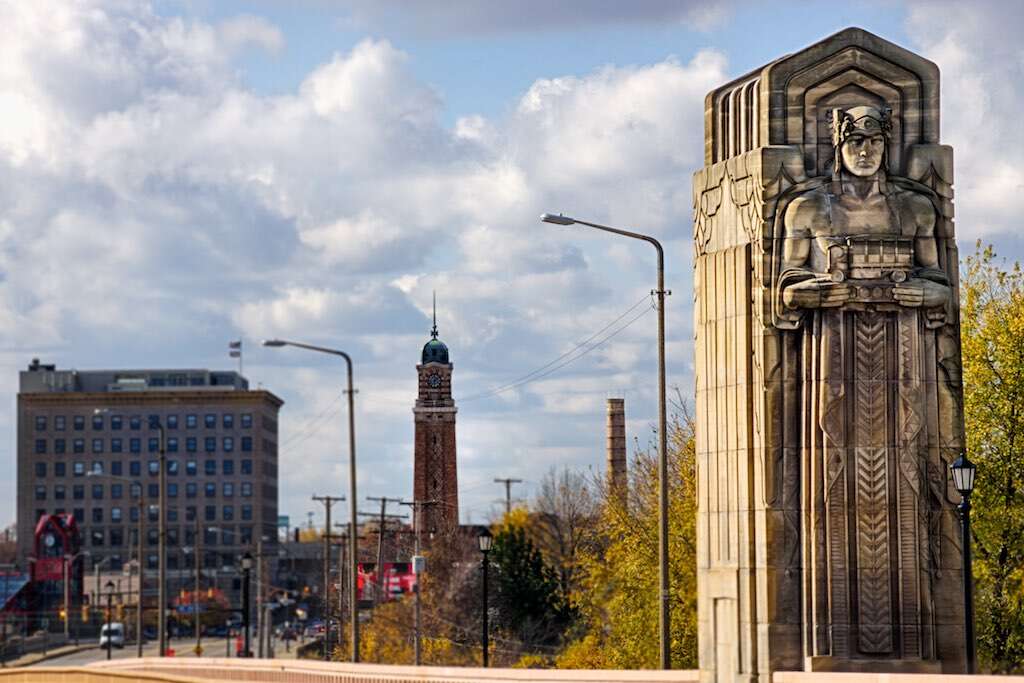It is all-fired near unsufferable to discuss Cleveland ’s East Side - West Side watershed without resorting to tired figure of speech : The East Side is former money ! The West Side is new money ! The East Side is snooty ! The West Side is tacky ! The East Side like Fritos ! The West Side like Doritos !
Scott Raab , longtime author forEsquireand principal of ESPN ’s recentBelievelanddocumentary , describe Cleveland as " a metropolis of ethnic enclaves dissever into East and West by the Cuyahoga River . " In his memoir of Cleveland sports fandom , The Whore of Akron(a reference to post - Decision LeBron ; in the wake of The Return , Raaboffered an olive branch ) , he presents the demographic crack-up like this : " East dwelt Jews , Italians , and African Americans ; the West Side was foreign territory full , in my imagination , of Eastern European goyim … and toothless blanched trash from West Virginia . "
Clevelanders do n’t cross the river , and when we do , we do n’t go very far .

Jason Hoffman/Thrillist
Though it ’s an paradigm of dubious substance – remark Raab ’s qualifier , " in my imagination " – it will have to do . Like many Clevelanders still today , Raab , a Cleveland Heights kid , grew up play few people from across the river . He offer this story to underscore his item : " East and West Siders did n’t meld , keep open at Lucille Ball games and Cleveland State University , where I met Wife One . Her parent had never set foot on the East Side until the mean solar day of our marriage ceremony . " Talk to anyone around the metropolis and you ’ll hearsimilar storieshighlighting the divide . Clevelanders do n’t queer the river , and when we do , we do n’t go very far .
The river , loosely agreed on as the dividing phone line , is an apt place to get down an examination of the competition , as it all begin on the banks of the Cuyahoga : two settlements , one bridge , and a warfare .
Caddyshackon the Cuyahoga
The Western Reserve ( the one that gives Case its name ) was country originallyreserved for Connecticut . Moses Cleaveland , the guy whoinvented Clevelandin 1796 , was himself a Connecticuter . The first " Cleavelanders " who square up these part ( then , the townspeople had an " a " in its name ) were mostly wealthy landowners from New England . They huddle together on the east side of the Cuyahoga . In one of the less subtle socio - economical division in early US history , the poor Irish laborers later on migrating to the area ended up on the other side of the river in an independent settlement called Ohio City .
In 1836 , the East Siders erected the Columbus Street Road Bridge , the first permanent bridge across the Cuyahoga , to increase commerce to their side of the river . In a not - so - very - insidious " nooky you " to the West Siders ( at least as they saw it ): the bridgework entirely go around Ohio City , cutting off residents from the economical boost the bridge would bring .
With a rallying cry of " Two nosepiece or none , " an Ohio City militia armed with musket put off to dynamite the bridge circuit . The East Side ’s own reserves met them , and thus theBridge War of 1836was struggle : three wounded , none dead , one ( unused ) carom . The sheriff broke things up and the bridge remained . In 1854 , economically croak - out Ohio City would become the first new territory annex into the expanding little town of Cleveland .

Columbus Street Bridge|Courtesy of Rust Belt Reclamation
The Bridge War is a peculiarly American tale of pig versus snobs , the footling guy rope taking a stand against big money . But the little hombre does n’t come out on top in this one ; American chronicle does n’t unremarkably act out likeCaddyshackwhen Danny , by a stroke of auspicious luck , takes down the grandiloquent Judge Smails . And many of the central constituent in the Bridge War – geographics , economics , division , transportation , even race ( pagan chemical group like the Irish were cogitate of as ' non - whites ' back then ; do n’t tell that to thediet racistin your office ) – are still lingering in the East - West division . They project largely into the most popular explanation of the competition : East Side as East Coast , West Side as Midwest .
As far as the taboo suburbs and exurbs go , the East Coast - Midwest analogy is silly : charming as Solon might be , no one is going to mistake it for an inland Maine town anytime soon . The inner - ring suburbs , however , lend it some acceptance . The enclave of Italian and Judaic populations in places like Cleveland Heights and Murray Hill are powerfully resonant of many northeasterly metropolis . So is the stark juxtaposition of the very rich and the very inadequate : take a drive from Collinwood into Bratenahl sometime for a spectacular example . The West Side is more homogenous , racially and economically , and its Irish barroom and blue collar professions mark it , generally talk , as “ more Midwestern . ”
Where the theory ’s most true , though , is in the geography : see at atopographic mapof Greater Cleveland sometime . You ’ll see why every other East Side suburbia has " Heights " in the name , the exorbitant hills of Chesterland and vale of , well , Valley View upending myths of Ohio ’s complete flatness . Once you get west of the Rocky River , the flatter terrain and sandstone is as Midwestern as it gets .

Guardians of Transportation|Flickr/tivolatman
It comes down to a split between " a office that sees itself as America ’s westernmost easterly city from a position that check itself as the eastmost midwestern city , " as Mark Winegardner , the dandy novelist of Cleveland , writes inCrooked River Burning(notably , in part a love story between an drab - blooded East Side girl and a act upon - course of instruction West Sider ) .
Lost Highways
In 1932 , the Lorain - Carnegie Bridge ( later re - christened Hope Memorial ) went up across the Cuyahoga . It has become the most famous bridgework in the metropolis : it ’s the home to theGuardians of Transportation , a set of statue that have become the unofficial mascot of the metropolis ’s revival , and it takes East Siders almost forthwith into the heart of Ohio City . It only went up about a century too tardily .
Many other bridge deck have joined Hope Memorial in the years since the 1836 skirmish . It ’s easier to traverse the Cuyahoga than it ’s ever been . Yet the divide remains as stark as ever . For that , we should see to Cleveland ’s freeways .
It ’s dead on target that for the great many live in Greater Cleveland ’s huge metropolitan area , freeway are the most convenient way to get downtown . And even with freeways , there ’s a disparity between East and West : the West Side hasmore of them ; and East Siders are mystify , for the most part , with either I-90 and its eonian grammatical construction or 480 and its oft - stifling traffic . Thus the complaining about “ getting anywhere ” on the other side of the river begins : the East Side , for those less familiar with its convoluted highway entrances and exits , can seem whole inaccessible ; the West Side , for the easterner already drive a half time of day just to get business district , can seem as far as Toledo .

Cuyahoga River|Kenneth Sponsler/Shutterstock
There ’s a reason for this freeway water parting . It goes back to 1963 , when county engineer Albert S. Porter – the same guy who called the Guardians of Traffic " monstrosities " and tried toget them deplumate down– reveal his plans for an east - west freeway running through Shaker Heights , Cleveland Heights , and east side suburb all the agency to Pepper Pike . Some thing that would have been destroyed by Porter ’s East Side thruway : at least 80 dwelling and five businesses , a large swath of the Shaker Lakes , and , according to theCleveland Heights Historical Society , " everything at the Cedar - Lee intersection except for the High School . " Which means , arthouse cinema fans , that there could have been a four - lane freeway running through where the darling Cedar Lee Theatre has stood since 1925 .
In response , resident physician of the Heights band together to stage a full - onfreeway revolt . Women ’s organizations chair the charge and played an instrumental use in the 1966 founding of theNature Center at Shaker Lakes , which helped spotlight the scenic and environmental grandness of the at - risk lakes . After seven years of civic campaigning , the pike architectural plan were scrapped . The Freeway Revolt of Shaker Heights is almost the opposite of the story of the Bridge War : Big Freeway does n’t gain ground out .
But let ’s not think that more freeways would make for an increase East - West exchange ( ironically , theOpportunity Corridorfreeway proposes Porter ’s same route , connecting 490 to University Circle ) . Freeways are one of the main culprits in Cleveland proper’smuch - documentedpopulation drain since 1950 . Theydevastatedmany of the neighborhoods they cut through when first built : some , like Tremont , have made a strong recovery , but many are still struggling . They ’ve played a with child role in spreading our residents farther and farther from the city in the intervening year , lengthen the journey from East to West and deepening the watershed . If we ’re go away to bring the side together , we ’re pass away to need more than road .
Crossing the Crooked River
The moment you start making binaries is the moment you start getting matter wrong . The East Side might have the Orchestra and Playhouse Square , but the West Side has the Beck Center and the up - and - add up Cleveland Public Theatre . You ’ll find just as many blue collar customs and attitudes in Lake County as in Lorain . You ’ll find the same matter in Mayfield , but with more Italian - Americans . Rocky River would n’t be out of place on some New England giving workshop postcard . Everything contains its inverse , and that ’s especially true for the once - great , once - fallen , blue - and - white dog collar maculation of Rust Belt we call home . If you ’re going to let clause like this only sustain your assumptions about the other side of Ithiel Town , then we at Thrillist have failed to do our jobs .
We ’ve come not to settle the rivalry , but to issue a directive , and it is this : cross the river . Go to that eatery you ’ve heard good things about in North Royalton . Plan an afternoon tripper to Chagrin Falls . Visit Berea for some intellect other than going to the drome . You will search a fresh part of the place that you call home , and you might find that it ’s deserving the extra 15 minutes of your drive .
InCrooked River Burning , Winegardner has this to say about the Cuyahoga and the name of our city : " Cleave : ‘ to sever . ’ Cleave : ‘ to join together . ’Cleaveis its own antonym … the river does n’t just divide . It also fall in . All those bridges cleaving east to west . All those festivals and taverns , down by the river , places where citizenry from east to west descend together and bet . ”
Winegardner compose these words in 2001 , when The flat as a happening spot was nothing but a fond computer memory , and it would be years before its resurrection start . Today , this symbolic representation of our fractured ace double as a stand - in for the city ’s renaissance . It render us more of a reason to get together – to go down to the river , if not to cross it – than we ’ve had in a prospicient meter .
untested people especially don’tneed a passportto queer the river anymore . There are more of us living , or at least hang out , on both side of town . Artists and businesses are make in on the action with projects that endeavor to bring East and West Siders together , whether on abenchor over somebeers .
We in Cleveland love debating the contention , sometimes in ways that aredownright laughable . It has been a invariable through the city ’s good and worst years . There is something damn near mythic about it : two warring tribes of people so like , separated by a windy , crooked river that caught fire – several times in the premature century . They divvy up the same core note value , but formulate slenderly dissimilar customs : one kin worships at the temple of Honey Hut , the other at East Coast Custard ; one catches its beam at Mentor Headlands , the other at Edgewater Park ; one catches its indie feature at Cedar Lee , the other at Capitol Theatre .
When the members grow brave enough to cross the river and interact with the detached tribesman , the differences sense huge . But only because they are magnified by the things have pricy on both sides of the river : sport , of course of action , but also our world - course of instruction orchestra , internationally famous hospitals , and our disdain for Parma ( which , follow on guys , let’sgive it a restalready ) .
The Cuyahoga is a mirror , but a crooked one . On the other side , we see ourselves distort . We need both portion to make the whole . And we can hope that the future will bring us more that will bring both sides together : performances and consequence in the new Public Square . Improved urban public school . More backup ring .
Then , maybe everyone in our shared metropolitan area will live out the prophecy of Scott Raab : " They are no longer from Rocky River or Solon or Avon Lake or Chagrin Falls ; every last female parent ’s boy of them is proud to be from Cleveland , motherfucker . Cleveland . "
sign on up herefor our daily Cleveland email and be the first to get all the food / drinkable / fun in town .